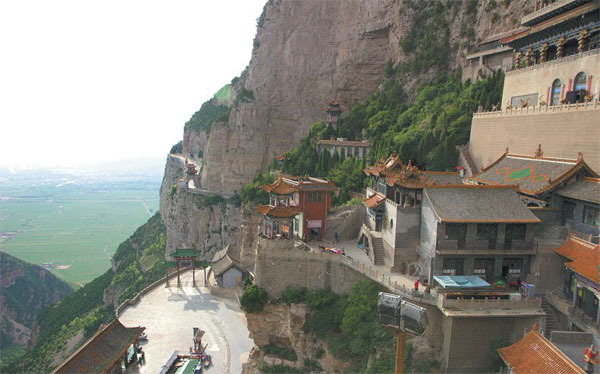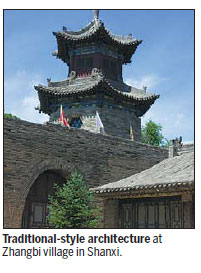Despite not featuring prominently in guidebooks, the province's unique culture and history allow it to take its place alongside the country's familiar tourist spots.
The summer sun shot shafts of dancing beams of light across the courtyard of a house that has been occupied for 16 generations by the same family.
The heat was still rising and the azure blue sky above was unbroken save for the occasional house martin swooping through the rooftops.
It was hot and the sweat trickled somewhat uncomfortably down my back.
Several of us were seated on wooden stools beneath the shade of a tree wrapped round with an ingeniously woven wickerwork umbrella as an amiable local official offered us sweet apricots to eat.
It was a magical moment which epitomized for me the essence of where we were, the very spirit of Shanxi province in North China.
The name sounds the same (to untuned Western ears at least) as Shaanxi province, where the famous Terracotta Warriors stand in serried reconstructed battle formation near Xi'an. Shanxi is, by comparison, somewhat overlooked.
I was accompanying a group of 14 semi-professional journalists, photographers and writers who had been invited by China Daily to visit Shanxi province as part of a provincial government initiative, the "Shanxi in the eyes of foreigners" program.
Like most foreigners I had little or no perception of Shanxi except for old reports of dirty coal mines, poor safety records and crushingly dreadful pollution.
Add to that tales of fabulously wealthy private mine owners splashing out multiple millions on extravagant parties, real estate, and fast cars, and my picture was anything but perfect.
So it was with a little trepidation that I accepted the invitation to attend and take what amounted to five days out of a very busy business schedule, which spans both China and the rest of the world.
Without doubt it was one of the best things I have ever done and one of my most memorable experiences in China to date.
Like many senior leaders in business, I am cosseted in meeting rooms, or on planes, most of the time.
The increasing speed of change in the world means that there is often little time to think, other than on the occasional few days of snatched holiday. It is a rare thing indeed to be still.
I hate being a tourist and I hate being herded around places by overzealous guides who bombard me with facts.
"That's what Google's for," said an equally skeptical colleague. Of course, he might also have said Baidu, which is China's leading search engine.
If I want the detail I can look it up. What I want is to experience the places I visit, to immerse myself in the history, to try to understand what it must have been like in the days when the buildings were inhabited by their original owners.
Although it is pretty well impossible to be alone or unguided on a whirlwind tour of Shanxi such as ours, I was determined to find the space I needed to reflect.
So, as the tour swept onward through the relics, I sought out the quiet and calm places, to contemplate, for a brief moment, how the merchant family in the Qiao's or Wang's Grand Courtyards, the people scuttling through the labyrinthine tunnels of Zhangbi village or the contemplative Buddhist monks in their monastery clinging to the side of Mian Mountain, must have felt.
I was so glad I did. Leaning against a wall in the shade of the Qiao's Grand Courtyard in Qiaojiabao Village, I was transported, for a moment at least, back to the days of the famous Chinese merchant Qiao Guifa during the Qing Dynasty (1644-1911). I closed my eyes and let my imagination wander.
Back in the heat of the little family courtyard 'hotel', for that is what it is now, time stood still for me.
I was told that 60 yuan ($9.23) a night would allow three people to have a shared room and three, somewhat frugal, meals a day.
Wandering outside and up a dusty track between crumbling walls that date back over 1,000 years, I was transported to a different time.
A funeral was taking place up the hill so I did not intrude, but watching the smoke rise I was struck by the notion that things here have probably not changed for up to a thousand years or more. It was a humbling experience.
For me the opportunity to see a different part of China, away from the teeming streets of Beijing and London where I spend a good deal of my time, was compeling. I was genuinely surprised by what I found, saw and experienced.
It is fair to say that Shanxi is a beautiful, beguiling place steeped in history and with a rich culture I had really not previously appreciated.
It is said to be the crucible of Chinese civilization, the place from which the Chinese people emerged, from along the banks of the great Yellow River, to rise to be what they are today.
Reading the Western guide books it is easy to be skeptical and the book I have used as my guide to China barely gives Shanxi more than two pages. It's a big book and its next destination is my bin.
It grossly undersells Shanxi, as do most of the Western guide books I have looked at.
I know China is big and there is a temptation for would-be visitors to focus on the usual suspects of the Forbidden City, Great Wall and Terracotta Warriors. Of course these are all 'must sees' but it is worth rescheduling the itinerary, if you can, to look elsewhere as well. Shanxi may not sound like a great place to go but like so much about China, it's wrong to believe all you read in the West. Put it on your list. You won't be disappointed.
Jon Geldart is the executive director - Markets Development at Grant Thornton International Ltd's China branch

|
Shanxi off ers tourists both an ancient view and spectacular natural scenery. Photos By Li Jin / China Daily |

(China Daily 07/22/2016 page12)